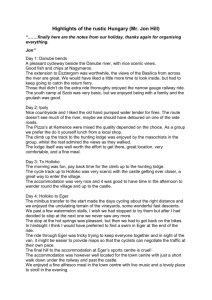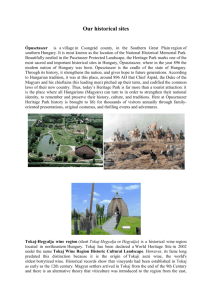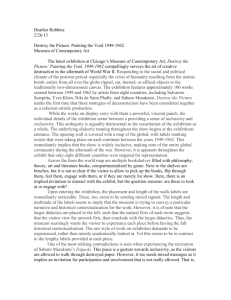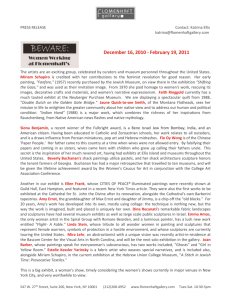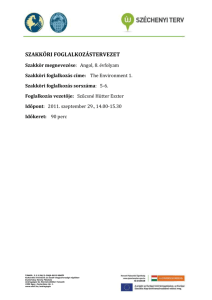Eger Castle
advertisement
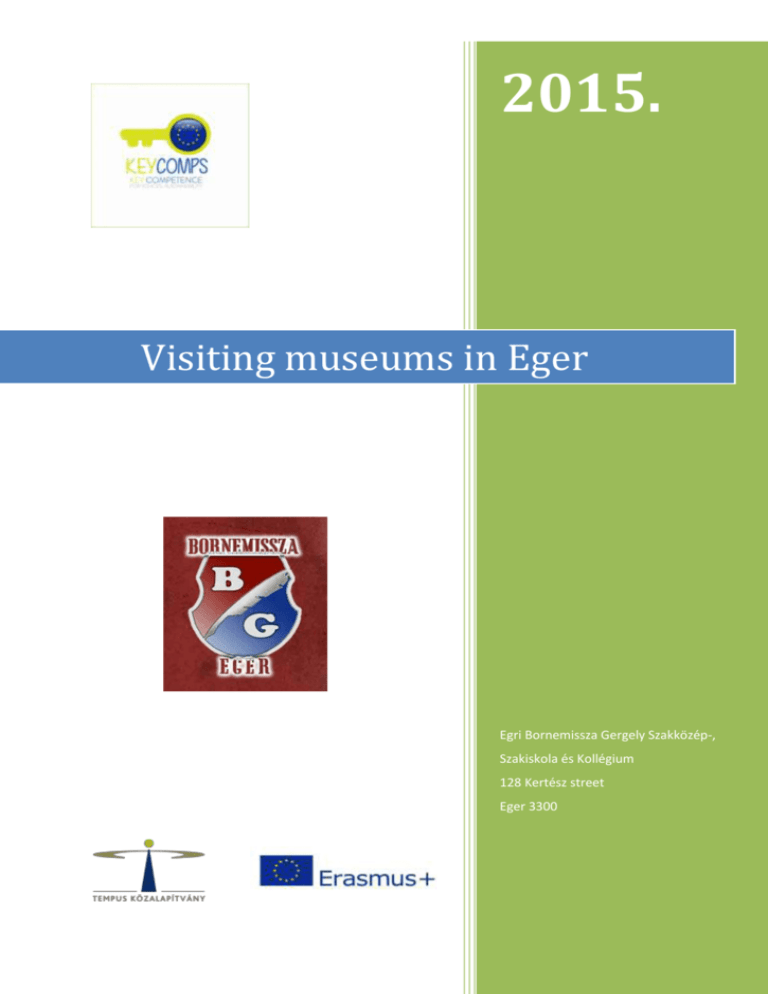
2015. Visiting museums in Eger Egri Bornemissza Gergely Szakközép-, Szakiskola és Kollégium 128 Kertész street Eger 3300 School ecoaudit Eger is the county seat of Heves, and the second largest city in Northern Hungary . Eger is best known for its castle, thermal baths, historic buildings, dishes and red wines. There are several museums in Eger and according to the tourists’ opinion the most popular ones are Eger Castle, Magic Tower, Géza Gárdonyi Memorial House, Firefighter Museum, Historical Warehouse and Kopcsik Marzipan Museum. Eger Castle History The first castle was built on the high hill named Várhegy at Felsőtárkány near Eger. During the Mongol invasion in 1241, this castle was ruined, and the bishop of Eger moved it to a rocky hill in the city of Eger. On the hill, a new castle was built, and it developed rapidly. In 1470 a Gothic palace was built. Archaeological excavations only started in 1925 and the castle was used by the army as barracks until 1957. István Dobó Castle Museum The exhibition of the history of the castle from Saint Stephen to the struggle of freedom of Rákóczy can be found on the first floor in the Gothic Bishop’s Palace. Visitors can follow the everyday life of border fortresses. In the Historical Collections there are badges, medals and statuettes, the industrial lifestyle relics, paper numismatic collection, in which 1848-49, 1944-45 need money rarities, lottery tickets, and shares can be seen. Visiting of this museum is followed by replicas, sound effects and pyrotechnic components. Prison Exhibition Executions, torture, humiliation of the Medieval Hungary There were houses of canons, bread dealers’, bakery and large granary on the west side of the palace courtyard. Today only the cellars remained which were under those buildings. Here you can find the Prison Exhibition where the medieval Hungarian punishment is presented. Tools for shaming, body punishment, mutilation, pillory (shame column) or different pallets can be seen in the first part of the exhibition. Another part of the exhibition presents types of medieval executions and their tools. During feudalism the execution served deterrence so they were implemented in public. Students can play situational games and after it they learn about the XVIII- XIX century practice of justice, the moral norm of religious and secular elite in Eger in that time. During summer students can take part in castle camp and they can follow what happen with the item found by an archaeologist, they can take part in the Knights' trial, can compete, play strategic games and create handmade items. The Magic Tower History In the city centre of Eger there can be found The Lyceum. It was started to build in 1763 by the plan of Fellner Jakab. Its tower was originally built as an observatory and there were world famous astronomy education. The observatory was planned by a Jesuit astronomer called Hell Miksa. At the very top of the tower on the 9th floor the Camera Obscura is situated. It was made by a locksmith, Fazola Lénárd. On the floor it is possible to see the Meridian Line made of Carrara marble and crystallised limestone from Hungary. The observation room is situated on the 10th floor and it was decorated for astronomical observation by the proposal of Hell Miksa. The tower was completed in 1776 and it was one of the most modern astronomical observation rooms in Europe. Tittel Pál and later Albert Ferenc worked here. Zétényi Endre lecturer went to the Teachers Training College in 1950. He was interested in the tower of the Lyceum. He organized those tools that can be found there and at the beginning of the 1960s during the renovation of the building he corrected and rebuilt the meridian of Eger. He equipped the astronomical exhibition partly with the remaining instruments and with those that were collected by him. The exhibition can be seen today as well. The Magic Tower The museum today works as a tourist attraction and it supports education, too. In the Magic Tower we can visit the Astronomical Museum, the Planetarium, the Magic Room, the Camera Obscura (periscope) and the panoramic terrace (where the advertised times telescope demonstrations are organized). Special lessons are held for student groups, preschoolers (by appointment) museum educational workshops in astronomy, biology, physics, chemistry and geography. Visitors of the Magic Hall can get to know basic physical phenomenon during making their own experiments. They can play scientific games. Visitors can watch original records of natural phenomenon on computers. It is possible to watch natural films on the Internet. Beyond the interactive experimentation an exhibition can be seen, which consists of old rocks and fossils from the Bükk Mountain. Teachers from the Department of Natural Sciences of Eszterházy Károly College hold special lessons for students groups and visitors as well in biology, physics, chemistry and geography. These high-quality demonstrations are held in pre-arranged topics and times. Géza Gárdonyi Memorial House The Géza Gárdonyi Memorial Museum was designed in the former house of the writer. Gárdonyi lived here from 1897 until his death in 1922. The house is being protected as a monument. Gárdonyi’s more novels were written in this house, but all of them the most prominent is The Eclipse of the Crescent Moon, which was written in 1901. This historical novel is about the fights against the Ottoman Empire in the sixteenth century. The house overlooks the Castle of Eger, which might serve as an inspiration during the writing of the novel. In one of the rooms of the house you can see the tens of thousands books collection, among which there are books with literary and other range of topics in Hungarian and German language, and which was the writer's own original books. To preserve them the originally open bookcase was glassed. In the study room there is a gable window that let natural light onto the writer’s desk, which helped him to work when his windows were closed to protect him from daytime noise. Here we can find Gárdonyi’s large desk and also the dulcimer of Pista Dankó, who was a famous gypsy primate of that time. It was Gárdonyi who gave him loan to be able to treat his lung disease. There can be found the writer's secret written notes in the showcases. The bedroom also offers a wide variety of original features with a small carved desk, on which The Eclipse of the Crescent Moon was probably born. Gárdonyi was not only a gifted writer, but also had an outstanding dexterity. This is evidenced by the paintings and landscapes, which were set on a school slate. The design of the house and the wall painting is the same with the originally built house, after the several renovations the original templates are tried to restore. The restores of the Eger Castle regularly review the building, and, on a weekly basis they measure the humidity in the rooms to detect any adverse effects quickly. Historical Warehouse The Historic Warehouse, which is Sándor Tóth’s private collection, is in the historical centre of Eger. The collection was restored by him. This is a permanent exhibition, where military equipments, guns, sabres, swords, authentic wears, and others can be seen from the prehistoric age to the times of the war of independence. The exhibition is completed with original and reconstructed costumes from different historical periods. The oldest piece in the collection is a more than 4,000 years old metal axe, which was found in a rural household. The very honoured relic of the museum is the funeral flag of Ferenc Rákóczi. Fire-Fighting Museum The Eger Museum of Fire Fighting was opened at 5 Tűzoltó Square, in the building of the former fire station in September 1999, on the 125th anniversary of the establishment of the fire service in Eger. In the archaic exhibition hall, the visitors can see the municipal fire fighting vehicles of historic value and learn about their assembly and use through a short fictional film. The building erected in 1929 for 3 fire engines. The Signalling Room presents the technical equipment used in the signalling stations of the 1940-50s, including the telephone exchange as their most important apparatus. In the Visual Treasury room, the devices used by volunteer and professional firemen can be viewed. Several devices can be found in the Restorer’s Workshop for demonstration purposes, including the Żuk pickup truck frequently used by volunteers and the fire engine used by traditionalist groups. Badges of honour as well as objects demonstrating pre-restoration conditions can be found here. Kopcsik Marzipania You can visit the sweet masterpieces of Lajos Kopcsik in Hanrangöntő street in Eger next to the Minaret not so far from the city centre. The museum was opened in 2005 with the support of the town. The masterpieces you can see in the museum „Marcipania” have been the results of several decades of creative work. In the showcases you can admire sugar-copies of mostly Hungarian Fine-, Applied-, and folk art masterpieces, competed with the symbols of Eger. The master had also the children in mind, so nicely decorated tale-books can be found in the showcases as well. You can see 150 pieces of marzipan objects in the museum. These objects were made from sugar, even the two-metre high wine bottle or the miniature copy of the minaret. The master had long been preoccupied with the idea of making a Baroque room from sugar. By now it has become reality: the floor, the wallpaper, the curtain in the room, the pictures the stucco, the stove, the sofa and the table in front were made from sugar. This room was created in three years. Protection of works of art About 5 km from the castle in the suburban area in a hidden corner lies the museum’s arts protecting place. In the building a 3728 m2 warehouse can be found in which there are 55 separated spaces and workshops for restorers and a photo studio. Hidden from visitors the restorers’ works are one of the most important museum activities. Tasks of restores are the preservation of museum artefacts and their aesthetic appearance in the exhibitions. Cleaning, conservation and restoring of works of art in the archaeological, historical, folk, art and literary collections are made by metal, silicate, textiles and wood art restorers. Our students are in Eger Castle In the Magic Tower In Géza Gárdonyi Memorial House In Historical Warehouse and Fire-Fighting Museum In Kopcsik Marzipania
